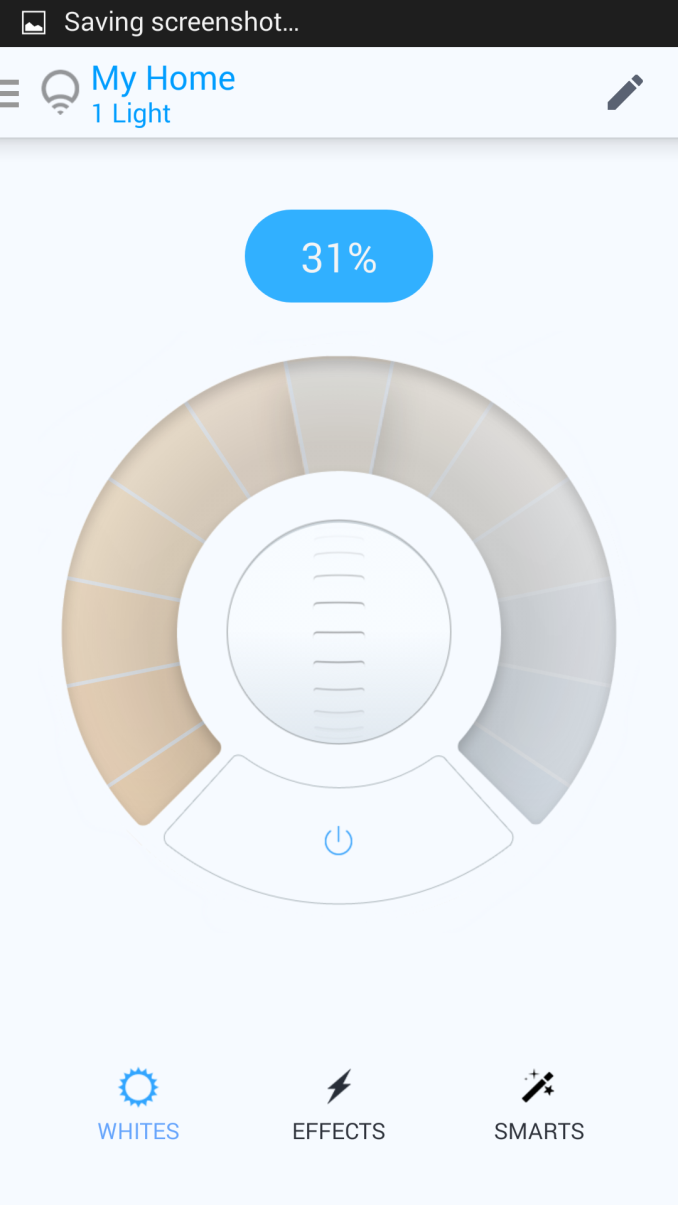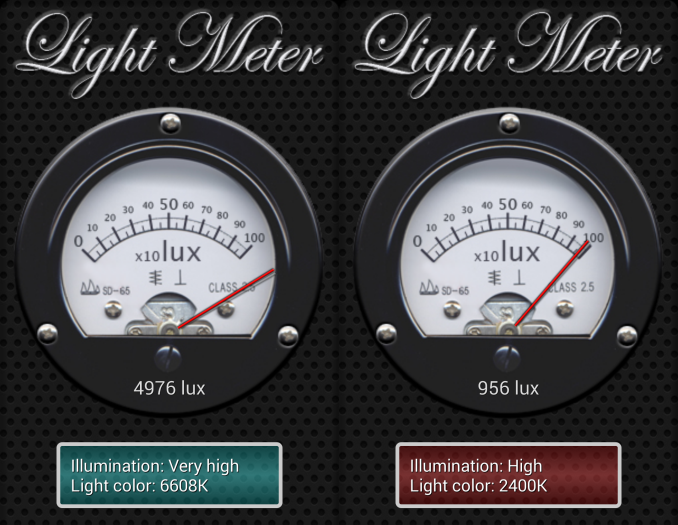LIFX White 800 Smart Bulb Review
by Ganesh T S on June 12, 2015 9:55 AM EST- Posted in
- Home Automation
- Wi-Fi
- Qualcomm Atheros
- LIFX
Setup, Usage and APIs
The setup process for the LIFX White 800 is similar to most other IoT devices. The unit boots up with its own SSID. A mobile device (iOS or Android) with the LIFX app pre-installed is made to connect to it. A LIFX account is associated with the device. It enables control over Internet with communication via LIFX's servers.
Dimming is achieved via the core thumb-wheel in the app's home page. Color temperature can be tuned using the dial around it.
Many of the other app features such as themes are applicable to the multi-colored light bulbs. However, the scheduling feature works well with the White 800.
On the whole, the app is straightforward and easy to use.
We measured color temperature of the light bulb's out with a Samsung Galaxy S4 using a Light Meter app. The color temperature dial in the LIFX app was set to the two extreme temperature points for the screenshots below.
The color temperature measured as per the specifications and was obviously evident to the naked eye.
LIFX has been quite popular with power users. The communication protocol was reverse engineered, and there are multiple open source projects based on them. lifx-http, lifxjs and lifx-java are examples. Firmware v2.00 messed up many of these apps. However, it also brought along support for the official HTTP APIs. The APIs are a very good starting point and allow simple apps, but, unfortunately relies on the LIFX's web servers being up and the user's Internet connection being active (it is cloud-only). Recently, the official LAN-only documentation was updated. Hopefully, local HTTP APIs are made available soon - either officially from LIFX or via third-party developers.
Initially, LIFX didn't appear power-user friendly after the launch of v2.00 of the firmware, but things are slowly getting better with the publishing of the LAN protocol. The main item in our wishlist with respect to usage / APIs is a web interface for the bulb - the ability to control the light temperature and brightness using a web browser. This interface could also double up as an official 'mobile app' for platforms such as Windows Mobile.
























55 Comments
View All Comments
ganeshts - Friday, June 12, 2015 - link
I think that should be easily achievable using the documentation that has already been provided by LIFX for the protocol. Maybe LIFX should add that option in their app itself. Will provide them feedback on it.nathanddrews - Friday, June 12, 2015 - link
Please also provide feedback that some users (such as myself) will not purchase cloud-only devices. I can already control all the lighting, media devices, and other devices in my home without the cloud, so there's no reason to buy this if it adds another hurdle or need for another app. That's really too bad.ganeshts - Friday, June 12, 2015 - link
Trust me, that is one of the first things I tell to anyone pitching home automation devices for coverage.That is also one of the main reasons we gave the Ubiquiti Networks mFi the 'Recommended' tag last time around.
Nogami - Monday, June 15, 2015 - link
Although it's not the same product, I do exactly this at home with my Philips Hue setup. We've re-done our entire condo with "smart LED bulbs", and besides saving power, having the ability to adjust colour and brightness automatically via a schedule is amazing. Easily the best "whole home" purchase we made last year.For example, at 11:30 at night, all lights except the bedroom gradually darken to "off" over about 10 minutes (leaving ample time to pause if we're staying up late), while the bedroom lights fade to about 50% intensity over 10 minutes and change to a very warm orange/red colour temperature.
At midnight, all bedroom lights except for a night-light dim down to "off" over 5 minutes, then the night-light goes down after that.
In the morning, light start out as a deep red/orange colour and gradually brighten over 20 minutes as we get up, and the colour temperature shifts to a more white colour as the cycle completes.
Then everything automatically shuts off as we're out the door to work. We also have some evening schedule settings to periodically dim lights off after 2-3 minutes every 60 minutes (the ones we tend to forget to turn off as we're around the house in the evenings), to save power.
modulusshift - Friday, June 12, 2015 - link
What's the CRI of these bulbs? I find that helps more than temperature alone for dark winter areas.ganeshts - Friday, June 12, 2015 - link
LIFX claims all their bulbs have CRI > 80. Unfortunately, I didn't test that out myself.SeannyB - Friday, June 12, 2015 - link
It'd be nice to see some more exact readings on color temperature (is there a green or magenta tint?), CRI and a color spectrum graph, but I suppose that would require an investment in a color spectrometer.On a general note... I love the idea of LED bulbs that can vary their color temperature throughout the day, but the price is way outside of the ballpark of regular old 2700K name-brand LED bulbs. Years after the Philips Hue, they're still in the early-adopter price range.
boozed - Friday, June 12, 2015 - link
A quick and dirty test that can be performed without any specialised equipment (Anandtech can't afford a spectrometer?) would be to take a photo of a neutral grey target illuminated only by the light bulb with a digital camera on which the white balance has been set to daylight. Obviously it doesn't give you a spectrum, but it will give you a reasonable idea of the comparative difference in colour temperature and cast between illuminators.And a simple DIY spectrometer consists of nothing more than a glass prism, a box with a narrow slit, a dark room and a camera.
Daniel Egger - Saturday, June 13, 2015 - link
Or better use a color correction card and shoot that under the lighting then use the software to create a color correction profile and put the results here. Something like the X-rite Color Checker Passport should work just fine for that.RBFL - Friday, June 12, 2015 - link
How do you observe audible humming? It would have to be quite severe!